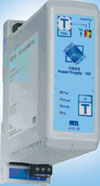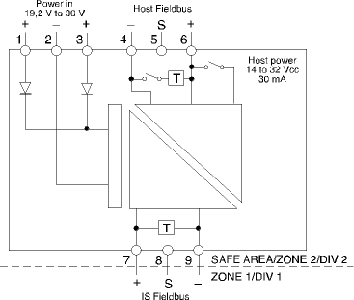

The increase in the use of fieldbus systems in hazardous areas was given a significant boost by the development of an international IEC standard for intrinsically safe (IS) fieldbus systems. This standard was based on experimental evidence and theoretical analysis done by the German Certification Body PTB and became known as the Fieldbus Intrinsically Safe Concept (FISCO). The first edition of the full standard (IEC 60079-27) was published in April 2005.
Introduction
PTB in collaboration with German industry examined the intrinsically safe needs of the 31,25 kbit/s physical layer of fieldbus and developed an approach applicable to both Profibus/PA and Foundation Fieldbus H1 Systems. A PTB report W-53e dated August 1994 provided details of the experimental evidence and the initial thinking on which an IEC document was based. From this proposal the IEC standard has emerged with only very minor modifications. The result is a comprehensive document, which covers all aspects of low frequency fieldbus systems allowing a system to be built requiring only minimum analysis of the safety requirements and simple documentation. The design or manufacture of the IS equipment was made slightly more difficult so that system configuration could be simplified. Arguably, this has tended to improve safety as the apparatus is certified, with the manufacturer subjected to surveillance, while system design and installation is less tightly controlled.
The initial IS fieldbus proposal was restricted to 'ia' IIC sources of power, while the FISCO specification permits power supplies to use non-linear regulation and the lower apparatus (gas) group IIB. This makes considerably more power available to the IS trunk and consequently enables more field devices to be supported on each IS trunk.
Cabling
One of the most interesting results of the experimental work was that adding standard instrument cable to a power supply reduces the incendivity of the system rather than increasing it. Previously it was assumed that the cable inductance and/or capacitance stored energy would be available to supplement the energy available from the source of power. However, the experimental evidence suggests that the cable parameters, because of their distributed nature, modify the form of the test apparatus spark so as to make it less incendive. There is also some theoretical analysis to support this view.
Because the experimental work covers only a limited range of cable parameters, circuit voltage and current, it was considered prudent to limit the acceptable cable parameters in a FISCO IS circuit to those in Table 1.

These limits are not restrictive, as a typical fieldbus trunk cable has parameters of 50 Ω/km, 0,8 mH/km and 120 nF/km. The length of the trunk is usually determined by operational requirements. The restriction of the length of the spurs can occasionally be irritating but if necessary this can be ameliorated by the use of additional current limitation.
In the longer term this work on cables may be applied to the design of all IS systems. This would require further work to determine the limits that are applicable, consequently, for the time being, the relaxation is only being applied to fieldbus systems.
Power supplies
The FISCO standard utilises recent work on the ignition capability of constant current power supplies to propose acceptable levels of power for supplies with a rectangular characteristic, as opposed to those with a falling, resistor-limited characteristic. This permits greater useable power for the fieldbus trunk, particularly if the less sensitive gas group IIB (ethylene) meets the installation requirements. See Figure 1.

The use of active current limitation restricts the categorisation to 'ib', but it is not usual for a fieldbus trunk to be installed in a zone 0. Any spur which is directly associated with a Zone 0 can be further protected to achieve 'ia' status. The original Foundation Fieldbus requirement was for a 'IIC ia' power supply, which was very restrictive, as indicated by the curves for the MTL5053 in Figure 1.
The available power is always considerably less than that of the safety description and Figure 1 illustrates the available power achieved by the MTL FISCO power supplies. The calculation of how many field devices can be powered from a power supply is a relatively simple application of Ohm's Law. The user takes into account the current consumption of each field, the voltage drop in the trunk cable, and the fact that field devices require 9 V to operate. If the assumption is made that the field devices require 20 mA and are all at the remote end of a 300 m trunk then this demonstrates the desirability of a IIB gas classification where that is acceptable. The number of devices connected to a bus is also determined by plant lay-out and consideration of the system reliability. The number of devices is usually quite low, five or six, with 10 being unusual. If the available trunk length is a limitation, moving the repeater power supply into the field, which may be Zone 2 or Division 2 may provide a solution.
A typical power supply is illustrated in Figure 2. This power supply incorporates isolation from its source of power and the host bus, the necessary terminator and some diagnostic capability. These are not FISCO requirements but are operationally desirable.

Field devices
The specification of the fieldbus field devices is determined by the requirements to be compatible with the power supplies and that additional devices should be able to be added to a system without having to reconsider the system safety. All devices have to be certified IIC and have input parameters of voltage (Ui) 17,5 V, current (li) 380 mA, power (Pi) 5,32 W, capacitance (Ci) 5 nF and inductance (Li) 10 μH. Devices may have any temperature classification, but the majority will be T4 (135°C).
The 5,32 W dissipation usually requires some form of power limitation in each device so as to achieve a T4 temperature classification, but there are fairly standard methods of doing this without much difficulty. It is possible to utilise devices certified to the original fieldbus specification by introducing some power limitation in the spur. This does however require a small modification to the supporting documentation.
Inspection and documentation
Major benefits of the FISCO system are that no detailed analysis is necessary to ensure the safety of the system, and additions do not require a re-evaluation of the whole system. The gas group of the system is determined by the power supply. The temperature classification of each piece of apparatus is determined by its certification (usually T4).
The documentation is only a list of the connected apparatus. This is normally done electronically and can readily cross-refer to the certification documents of the apparatus.
A further advantage of this system is that inspection procedure is reduced to ensuring that the system is unchanged and undamaged. Many of the field devices carry a unique identifier and part of the inspection procedure can be done automatically as part of the plant's asset management program. An occasional inspection for mechanical damage is still necessary.
Conclusion
When a full range of FISCO devices are available, it will be possible to assemble a system without a detailed analysis and documentation, confident in the knowledge that it will be safe. It will be simpler and possibly also safer than the equivalent conventional system.
The use of non-linear power supplies enables sufficient field devices to be connected to a single trunk, particularly if an IIB gas classification is acceptable.
The FISCO technical specification is the first simplification of explosion protection standards since the rationalisation of the gas grouping. "For these small mercies much thanks."
| Tel: | +27 10 055 7300/1 |
| Email: | sales@extech.co.za |
| www: | www.extech.co.za |
| Articles: | More information and articles about Extech Safety Systems |
© Technews Publishing (Pty) Ltd | All Rights Reserved